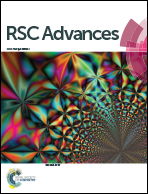Adsorptive desulfurization of dibenzothiophene over lignin-derived biochar by one-step modification with potassium hydrogen phthalate†
Abstract
A novel and efficient porous biochar was produced from alkali lignin via a synchronous carbonization/activation process and applied for the adsorption desulfurization of dibenzothiophene (DBT) at ambient temperature. Potassium hydrogen phthalate (KHP) was used as the activator for the first time, with the advantages of the autocatalytic activity of K+ for pore-creation, natural acidity for acid-catalyzed decomposition and surface oxidative modification of the lignin-derived biochar. The highest adsorption efficiency and adsorption capacity of DBT achieved were 98.8% and 33.8 mg S g−1, respectively, with the char yield up to 40 wt%. Analytical techniques such as BET, SEM, FTIR, TG/DTG and Boehm titration were employed and demonstrated that KHP was a promising activator for the highly porous structure and rich surface acidity of biochar. The isotherm data could be well described by the Langmuir model. Finally, the biochar could be regenerated 5 times with over 90% char yield and retain a high adsorption capacity of 29.2 mg S g−1.


 Please wait while we load your content...
Please wait while we load your content...